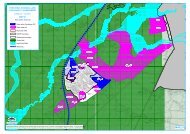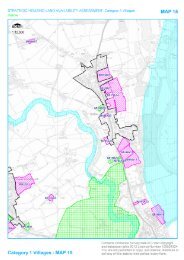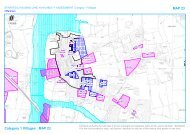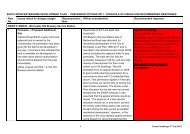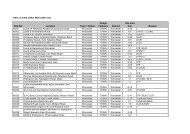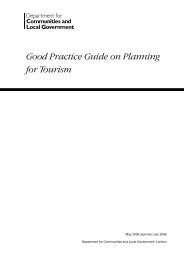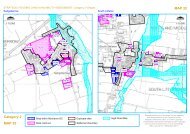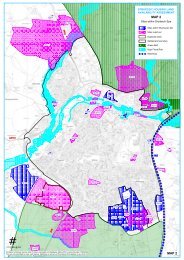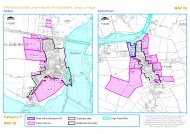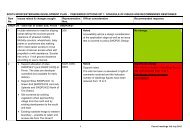Strategic Flood Risk Assessment - South Worcestershire ...
Strategic Flood Risk Assessment - South Worcestershire ...
Strategic Flood Risk Assessment - South Worcestershire ...
You also want an ePaper? Increase the reach of your titles
YUMPU automatically turns print PDFs into web optimized ePapers that Google loves.
Temporary BarriersTemporary barriers consist of moveable flood defences which can be fitted into doorways and/orwindows. The permanent fixings required to install these temporary defences should be discreteand keep architectural impact to a minimum. On a smaller scale temporary snap on covers forairbricks and air vents can also be fitted to prevent the entrance of flood water.Permanent barriersPermanent barriers can include built up doorsteps, rendered brick walls and toughened glassbarriers.Wet-proofingInterior design to reduce damage caused by flooding, for example:Electrical circuitry installed at a higher level with power cables being carried down fromthe ceiling rather than up from the floor level.Water-resistant materials for floors, walls and fixtures.If redeveloping existing basements, new electrical circuitry installed at a higher level with powercables being carried down from the ceiling rather than up from the floor level to minimisedamage if the development floods.Resilience measures will be specific to the nature of flood risk, and as such will be informed anddetermined by the FRA.8.8 Managing flood risk from other sources8.8.1 Surface water and sewer floodingWhere new development is in an area where the public sewerage network does not currentlyhave sufficient spare capacity to accept additional development flows it is recommended that thedeveloper discusses such issues with Severn Trent Water at the earliest possible stage. Thedevelopment should improve the drainage infrastructure to reduce flood risk on site. It isimportant however that a drainage impact assessment shows that this will not increase flood riskelsewhere, and the drainage requirements regarding runoff rates and SUDS for newdevelopment are met.If residual surface water flood risk remains, the likely flow routes and depths across the siteshould be modelled. The site should be designed so that these flow routes are preserved andbuilding design should provide resilience against this residual risk.When redeveloping existing buildings, the installation of some permanent or temporary floodproofingand resilience measures could prevent against both surface water and sewer flooding.Non-return valves prevent water entering the property from drains and sewers. Non-returnvalves can be installed within gravity sewers or drains, within the property’s private sewerupstream of the public sewerage system. These need to be carefully installed and must beregularly maintained. Additionally, manhole covers within the property’s grounds could besealed to prevent surcharging.8.8.2 GroundwaterGroundwater flooding has a very different flood mechanism to any other and for this reasonmany conventional flood defence and mitigation methods are not suitable. The only way to fullyreduce flood risk would be through building design, ensuring floor levels are raised above thewater levels caused by a 1% annual probability fluvial / 0.5% annual probability tidal plus climatechange event. Site design would also need to preserve any flow routes followed by thegroundwater overland to ensure flood risk is not increased downstream.When redeveloping existing buildings it may be acceptable to install pumps in basements as aresilience measure. However for new development this is unlikely to be considered anacceptable solution.2012s5947 S <strong>Worcestershire</strong> Level 2 SFRA Update FINAL Report v1.0.doc 178




